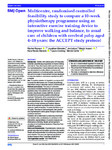Multicentre, randomised controlled feasibility study to compare a 10-week physiotherapy programme using an interactive exercise training device to improve walking and balance, to usual care of children with cerebral palsy aged 4–18 years: the ACCEPT study protocol
| dc.contributor.author | Rapson, R | |
| dc.contributor.author | Marsden, Jonathan | |
| dc.contributor.author | Latour, Jos M | |
| dc.contributor.author | Ingram, Wendy | |
| dc.contributor.author | Stevens, KN | |
| dc.contributor.author | Cocking, L | |
| dc.contributor.author | Carter, B | |
| dc.date.accessioned | 2022-06-08T14:47:21Z | |
| dc.date.available | 2022-06-08T14:47:21Z | |
| dc.date.issued | 2022-05-30 | |
| dc.identifier.issn | 2044-6055 | |
| dc.identifier.issn | 2044-6055 | |
| dc.identifier.other | e058916 | |
| dc.identifier.uri | http://hdl.handle.net/10026.1/19282 | |
| dc.description.abstract |
<jats:sec><jats:title>Introduction</jats:title><jats:p>Children with cerebral palsy (CP) frequently undertake physiotherapy programmes to improve walking and balance. They often require adult support to exercise in a functional position. A novel interactive exercise trainer has been devised to enable children to exercise with against resistance in a functional position, but its efficacy has yet to be proved. A novel protocol has been developed to determine whether a randomised controlled trial (RCT) is feasible.</jats:p></jats:sec><jats:sec><jats:title>Aim</jats:title><jats:p>To establish whether it is feasible to conduct an RCT to assess the effectiveness of a 10-week physiotherapy intervention using an interactive trainer in children with CP.</jats:p></jats:sec><jats:sec><jats:title>Methods and analysis</jats:title><jats:p>This study is multicentre randomised controlled feasibility trial with an embedded qualitative study. Forty children with CP, Gross Motor Function Classification System (GMFCS) I–III will be recruited from community paediatric physiotherapy caseloads. Participants will be randomised to 10 weeks of training with the interactive training device or to usual physiotherapy care. The mediolateral motion of the centre of mass estimate and Paediatric Balance Scale will be explored as potential primary outcomes measures, tested at baseline, 10 weeks and follow-up at 20 weeks. The views of child participants, their parents and physiotherapists will be gained through e-diaries and qualitative interviews.</jats:p><jats:p>Feasibility will be determined by examining recruitment and retention rates, completeness of, adherence to the intervention, appropriateness of outcome measures and effectiveness of blinding. Results will be reported in accordance to Consolidated Standards of Reporting Trials (CONSORT) guidelines.</jats:p></jats:sec><jats:sec><jats:title>Ethics and dissemination</jats:title><jats:p>Physiotherapists, children and parents have informed trial design and information leaflets. Results will be disseminated via publications, conferences and to families. This study has approval from North of Scotland Research Ethics Committee (20/NS/0018).</jats:p></jats:sec><jats:sec><jats:title>Trial registration number</jats:title><jats:p><jats:ext-link xmlns:xlink="http://www.w3.org/1999/xlink" ext-link-type="isrctn" xlink:href="ISRCTN80878394">ISRCTN80878394</jats:ext-link>.</jats:p></jats:sec> | |
| dc.format.extent | e058916-e058916 | |
| dc.format.medium | Electronic | |
| dc.language | en | |
| dc.language.iso | eng | |
| dc.publisher | BMJ Publishing Group | |
| dc.subject | Paediatric neurology | |
| dc.subject | REHABILITATION MEDICINE | |
| dc.subject | Developmental neurology & neurodisability | |
| dc.title | Multicentre, randomised controlled feasibility study to compare a 10-week physiotherapy programme using an interactive exercise training device to improve walking and balance, to usual care of children with cerebral palsy aged 4–18 years: the ACCEPT study protocol | |
| dc.type | journal-article | |
| dc.type | Clinical Trial Protocol | |
| dc.type | Journal Article | |
| plymouth.author-url | https://www.webofscience.com/api/gateway?GWVersion=2&SrcApp=PARTNER_APP&SrcAuth=LinksAMR&KeyUT=WOS:000804163100004&DestLinkType=FullRecord&DestApp=ALL_WOS&UsrCustomerID=11bb513d99f797142bcfeffcc58ea008 | |
| plymouth.issue | 5 | |
| plymouth.volume | 12 | |
| plymouth.publication-status | Published | |
| plymouth.journal | BMJ Open | |
| dc.identifier.doi | 10.1136/bmjopen-2021-058916 | |
| plymouth.organisational-group | /Plymouth | |
| plymouth.organisational-group | /Plymouth/Faculty of Health | |
| plymouth.organisational-group | /Plymouth/Faculty of Health/Peninsula Medical School | |
| plymouth.organisational-group | /Plymouth/Faculty of Health/School of Nursing and Midwifery | |
| plymouth.organisational-group | /Plymouth/REF 2021 Researchers by UoA | |
| plymouth.organisational-group | /Plymouth/REF 2021 Researchers by UoA/UoA03 Allied Health Professions, Dentistry, Nursing and Pharmacy | |
| plymouth.organisational-group | /Plymouth/Research Groups | |
| plymouth.organisational-group | /Plymouth/Research Groups/Institute of Health and Community | |
| plymouth.organisational-group | /Plymouth/Research Groups/Institute of Translational and Stratified Medicine (ITSMED) | |
| plymouth.organisational-group | /Plymouth/Research Groups/Institute of Translational and Stratified Medicine (ITSMED)/CCT&PS | |
| plymouth.organisational-group | /Plymouth/Research Groups/Plymouth Institute of Health and Care Research (PIHR) | |
| plymouth.organisational-group | /Plymouth/Users by role | |
| plymouth.organisational-group | /Plymouth/Users by role/Academics | |
| dc.publisher.place | England | |
| dcterms.dateAccepted | 2022-05-06 | |
| dc.rights.embargodate | 2022-6-10 | |
| dc.identifier.eissn | 2044-6055 | |
| dc.rights.embargoperiod | Not known | |
| rioxxterms.versionofrecord | 10.1136/bmjopen-2021-058916 | |
| rioxxterms.licenseref.uri | http://www.rioxx.net/licenses/all-rights-reserved | |
| rioxxterms.type | Journal Article/Review |


